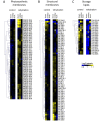Metabolomic response of Calotropis procera growing in the desert to changes in water availability
- PMID: 24520340
- PMCID: PMC3919747
- DOI: 10.1371/journal.pone.0087895
Metabolomic response of Calotropis procera growing in the desert to changes in water availability
Abstract
Water availability is a major limitation for agricultural productivity. Plants growing in severe arid climates such as deserts provide tools for studying plant growth and performance under extreme drought conditions. The perennial species Calotropis procera used in this study is a shrub growing in many arid areas which has an exceptional ability to adapt and be productive in severe arid conditions. We describe the results of studying the metabolomic response of wild C procera plants growing in the desert to a one time water supply. Leaves of C. procera plants were taken at three time points before and 1 hour, 6 hours and 12 hours after watering and subjected to a metabolomics and lipidomics analysis. Analysis of the data reveals that within one hour after watering C. procera has already responded on the metabolic level to the sudden water availability as evidenced by major changes such as increased levels of most amino acids, a decrease in sucrose, raffinose and maltitol, a decrease in storage lipids (triacylglycerols) and an increase in membrane lipids including photosynthetic membranes. These changes still prevail at the 6 hour time point after watering however 12 hours after watering the metabolomics data are essentially indistinguishable from the prewatering state thus demonstrating not only a rapid response to water availability but also a rapid response to loss of water. Taken together these data suggest that the ability of C. procera to survive under the very harsh drought conditions prevailing in the desert might be associated with its rapid adjustments to water availability and losses.
Conflict of interest statement
Figures






References
-
- Lopes MS, Araus JL, van Heerden PDR, Foyer CH (2011) Enhancing drought tolerance in C-4 crops. Journal of Experimental Botany 62: 3135–3153. - PubMed
-
- Messina CD, Podlich D, Dong Z, Samples M, Cooper M (2011) Yield-trait performance landscapes: from theory to application in breeding maize for drought tolerance. Journal of Experimental Botany 62: 855–868. - PubMed
Publication types
MeSH terms
Substances
LinkOut - more resources
Full Text Sources
Other Literature Sources

